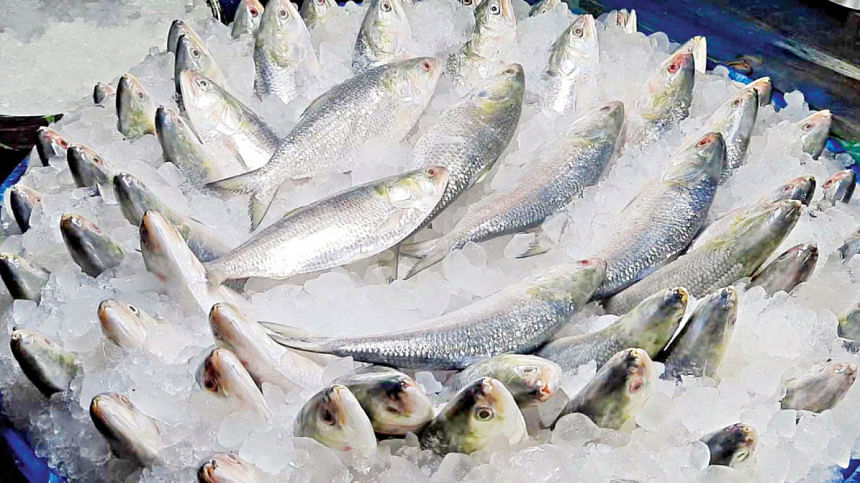Hilsa production hits seven-year low

Hilsa production in the country fell to its lowest in seven years in the 2023-24 season, according to data from the Department of Fisheries.
Experts have attributed the decline to erratic weather conditions, overfishing, navigability issues, and the growing impacts of climate change.
According to the Barishal Divisional Fisheries Office, hilsa production stood at 5.29 lakh tonnes -- around 42,000 tonnes less than the previous year.
In recent years, hilsa yields had shown a consistent upward trend: 5.71 lakh tonnes in 2022-23, 5.66 lakh tonnes in 2021-22, 5.65 lakh tonnes in 2020-21, 5.50 lakh tonnes in 2019-20, and 5.32 lakh tonnes in 2018-19.
Dr Mohammad Abu Kawsar Didar, a scientific officer at the riverine station of the Bangladesh Fisheries Research Institute in Chandpur, said adverse weather last year prevented many fishermen from going out to sea or rivers, resulting in a reduced overall catch.
He also pointed to a navigability crisis along major hilsa migration routes such as the Meghna-Tetulia, Payra-Bishkhali, and Sundarbans regions.
"Hilsa typically prefer water with a depth of over five metres, but in many of these routes, depth has fallen to two or three metres, obstructing the natural migratory flow," he said.
Dr Didar said overfishing along these routes has worsened the situation. "There's a limit to how much hilsa can be harvested sustainably -- and we've crossed that threshold," he noted.
Narendranath Biswas, deputy director of the Barishal divisional fisheries office, acknowledged the decline in production, saying fewer hilsa are arriving through the main migratory routes, directly affecting overall yields.

He, however, expressed hope for better catches during the peak season in June and July, crediting ongoing efforts to protect juvenile hilsa (jatka). But he admitted that many fishermen continue to harvest jatka illegally, undermining conservation efforts.
"Unfortunately, guarding hundreds of kilometres across rivers and estuaries is nearly impossible," he said.
Fishermen say the dwindling catch is making it increasingly difficult for them to survive.
"We are struggling. The quantity of hilsa we caught last year wasn't enough to pay off our debts. It's been years since we netted more than two maunds in a single trip. With river catch dwindling, we're now forced to go deeper into the sea—facing greater risks and more accidents," said Alauddin Mia, a fisherman from Bhola Sadar upazila.
Ibrahim Majhi, a fisherman from Kuakata, said, "Sometimes, we return empty-handed. Spending over Tk 2 lakh per trip has pushed us deep into debt."
Fishermen have called for stricter enforcement against illegal nets and intensified monitoring to protect jatka and ensure sustainable hilsa yields.
Meanwhile, prices of hilsa in Barishal markets have soared, driven by dwindling supply and increased demand ahead of Pahela Baishakh.
At Port Road Market -- one of the largest hilsa trading hubs in the south -- sellers said prices have risen sharply as wholesale traders hoard fish in anticipation of festival demand.
"Demand has spiked as hotels and restaurants in major cities like Dhaka and Chattogram have sent agents to secure hilsa for their Baishakhi menus. Whatever little we get isn't even enough to meet local demand. As supply shrinks, prices are shooting up," said Zahir Sikder, a fish trader at the market.
Hilsas weighing around 500 grammes are now selling for around Tk 1,100 per kg, while larger ones over 1kg are going for over Tk 3,000 per kg -- more than double the rate of a couple of weeks ago. Prices of smaller hilsa (200–300g) have also jumped by at least 50 percent compared to just before Eid-ul-Fitr.
Barishal District Fisheries Officer Ripon Kanti Ghosh said fishing is currently banned in key spawning grounds in Hizla, Mehendiganj, and Bhola until April 30.
"This, along with jatka conservation drives, significantly reduced market supply, causing the recent price hike," he added.

 For all latest news, follow The Daily Star's Google News channel.
For all latest news, follow The Daily Star's Google News channel. 




Comments